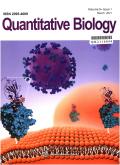Significance of differential allelic expression in phenotypic plasticity and evolutionary potential of microbial eukaryotes
IF 1.4
4区 生物学
Q4 MATHEMATICAL & COMPUTATIONAL BIOLOGY
引用次数: 0
Abstract
Background: Differential allelic expression (DAE) plays a key role in the regulation of many biological processes, and it may also play a role in adaptive evolution. Recently, environment-dependent DAE has been observed in species of marine phytoplankton, and most remarkably, alleles that showed the highest level of DAE also showed the fastest rate of evolution. Methods: To better understand the role of DAE in adaptive evolution and phenotypic plasticity, we developed a 2-D cellular automata model “ DAEsy-World ” that builds on the classical Daisyworld model. Results: Simulations show that DAE delineates the evolution of alternative alleles of a gene, enabling the two alleles to adapt to different environmental conditions and sub-functionalize. With DAE, the build-up of genetic polymorphisms within genes is driven by positive selection rather than strict neutral evolution, and this can enhance phenotypic plasticity. Moreover, in sexually reproducing organisms, DAE also increased the standing genetic variation, augmenting a species ’ adaptive evolutionary potential and ability to respond to fl uctuating and/or changing conditions ( cf . genetic assimilation). We furthermore show that DAE is likely to evolve in fl uctuating environmental conditions. Conclusions: DAE increases the adaptive evolutionary potential of both sexual and asexually reproducing organisms, and it may affect the pattern of nucleotide substitutions of genes. Author summary: In diploid organisms, the differential expression of the two alleles of a gene gives individuals more opportunities to adapt to fl uctuating environmental conditions, which is particularly bene fi cial for clonally reproducing species.差异等位基因表达在微生物真核生物表型可塑性和进化潜力中的意义
背景:差异等位基因表达(Differential allelic expression, DAE)在许多生物过程的调控中起着关键作用,并可能在适应性进化中发挥作用。近年来,在海洋浮游植物中也发现了环境依赖性DAE,最显著的是,DAE水平最高的等位基因进化速度最快。方法:为了更好地理解DAE在适应进化和表型可塑性中的作用,我们在经典的Daisyworld模型的基础上建立了一个二维细胞自动机模型“Daisyworld”。结果:模拟结果表明,DAE描述了一个基因的替代等位基因的进化,使两个等位基因能够适应不同的环境条件并实现亚功能化。在DAE中,基因内遗传多态性的建立是由正选择而不是严格的中性进化驱动的,这可以增强表型可塑性。此外,在有性生殖的生物中,DAE还增加了现有的遗传变异,增强了物种的适应性进化潜力和对波动和/或变化的条件作出反应的能力(参见。遗传同化)。我们进一步表明,DAE可能在波动的环境条件下进化。结论:DAE增加了有性生殖和无性生殖生物的适应性进化潜力,并可能影响基因的核苷酸替换模式。作者总结:在二倍体生物中,一个基因的两个等位基因的差异表达使个体有更多的机会适应变化的环境条件,这对无性繁殖的物种尤其有利。
本文章由计算机程序翻译,如有差异,请以英文原文为准。
求助全文
约1分钟内获得全文
求助全文
来源期刊

Quantitative Biology
MATHEMATICAL & COMPUTATIONAL BIOLOGY-
CiteScore
5.00
自引率
3.20%
发文量
264
期刊介绍:
Quantitative Biology is an interdisciplinary journal that focuses on original research that uses quantitative approaches and technologies to analyze and integrate biological systems, construct and model engineered life systems, and gain a deeper understanding of the life sciences. It aims to provide a platform for not only the analysis but also the integration and construction of biological systems. It is a quarterly journal seeking to provide an inter- and multi-disciplinary forum for a broad blend of peer-reviewed academic papers in order to promote rapid communication and exchange between scientists in the East and the West. The content of Quantitative Biology will mainly focus on the two broad and related areas: ·bioinformatics and computational biology, which focuses on dealing with information technologies and computational methodologies that can efficiently and accurately manipulate –omics data and transform molecular information into biological knowledge. ·systems and synthetic biology, which focuses on complex interactions in biological systems and the emergent functional properties, and on the design and construction of new biological functions and systems. Its goal is to reflect the significant advances made in quantitatively investigating and modeling both natural and engineered life systems at the molecular and higher levels. The journal particularly encourages original papers that link novel theory with cutting-edge experiments, especially in the newly emerging and multi-disciplinary areas of research. The journal also welcomes high-quality reviews and perspective articles.
 求助内容:
求助内容: 应助结果提醒方式:
应助结果提醒方式:


